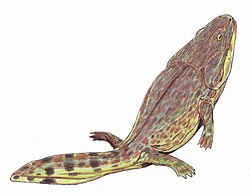| Buettnererpeton Temporal range: Late Triassic | |
|---|---|
 | |
| Holotype skull | |
 | |
| Life restoration | |
| Scientific classification | |
| Kingdom: | Animalia |
| Phylum: | Chordata |
| Clade: | Tetrapoda |
| Order: | † Temnospondyli |
| Suborder: | † Stereospondyli |
| Family: | † Metoposauridae |
| Genus: | † Buettnererpeton Gee & Kufner, 2022 |
| Type species | |
| †Buettnererpeton bakeri Case, 1931 | |
| Synonyms | |
List
| |
Buettnererpeton is an extinct genus of large temnospondyls known from the Late Triassic Dockum Group in Texas. The type species, B. bakeri, was long classified as part of other genera, such as Metoposaurus and Koskinonodon , but was placed in its own genus in 2022. [1]

